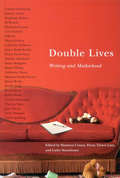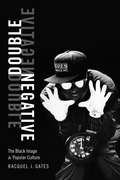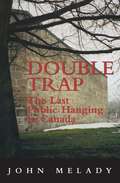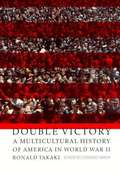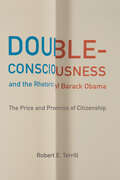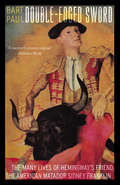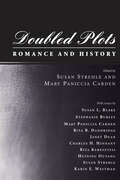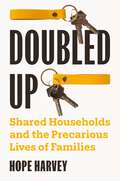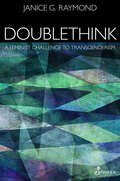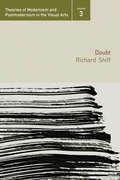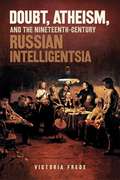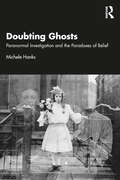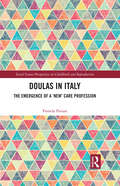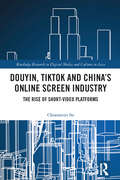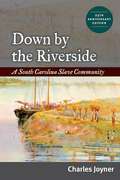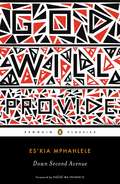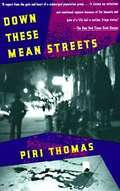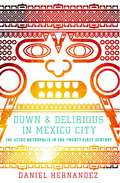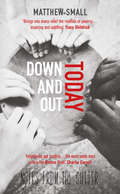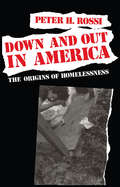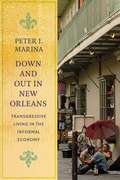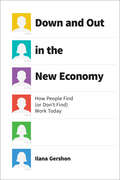- Table View
- List View
Double Lives: Writing and Motherhood
by Shannon CowanWriting is intellectual, solitary work, and mothering too often seen as its antithesis. Marni Jackson's The Mother Zone, published in 1992, gave many readers their first insights into the life of a mother/writer. Yet despite having writers such as Adrienne Rich, Alice Munro, Tillie Olsen and Margaret Laurence to guide and inspire them, mothers who are writers still often feel overwhelmed - even in the 21st century, a writer new to mothering may wonder if she will ever write again. In Double Lives, the first Canadian literary anthology focusing on mothering and writing, twenty-two writers, who range in reputation from seasoned professionals to noteworthy new talents, reveal the intimate challenges and private rewards of nurturing children while pursuing the passion to write. Varying widely in age, marital status, sexual orientation, culture/ethnicity, and philosophical stance, authors such as Di Brandt, Stephanie Bolster, Linda Spalding, Janice Kulyk Keefer, Sharron Proulx-Turner, Sally Ito Rachel Rose and Susan Olding, make significant and illuminating contributions to our understanding of how writer and mother co-exist.
Double Negative: The Black Image and Popular Culture
by Racquel J. GatesFrom the antics of Flavor Flav on Flavor of Love to the brazen behavior of the women on Love & Hip Hop, so-called negative images of African Americans are a recurrent mainstay of contemporary American media representations. <P><P>In Double Negative Racquel J. Gates examines the generative potential of such images, showing how some of the most disreputable representations of black people in popular media can strategically pose questions about blackness, black culture, and American society in ways that more respectable ones cannot. <P><P>Rather than falling back on claims that negative portrayals hinder black progress, Gates demonstrates how reality shows such as Basketball Wives, comedians like Katt Williams, and movies like Coming to America play on "negative" images to take up questions of assimilation and upward mobility, provide a respite from the demands of respectability, and explore subversive ideas. By using negativity as a framework to illustrate these texts' social and political work as they reverberate across black culture, Gates opens up new lines of inquiry for black cultural studies.
Double Paradox
by Andrew WedemanAccording to conventional wisdom, rising corruption reduces economic growth. And yet, between 1978 and 2010, even as officials were looting state coffers, extorting bribes, raking in kickbacks, and scraping off rents at unprecedented rates, the Chinese economy grew at an average annual rate of 9 percent. In Double Paradox, Andrew Wedeman seeks to explain why the Chinese economy performed so well despite widespread corruption at almost kleptocratic levels. Wedeman finds that the Chinese economy was able to survive predatory corruption because corruption did not explode until after economic reforms had unleashed dynamic growth. To a considerable extent corruption was also a by-product of the transfer of undervalued assets from the state to the emerging private and corporate sectors and a scramble to capture the windfall profits created by their transfer. Perhaps most critically, an anti-corruption campaign, however flawed, has proved sufficient to prevent corruption from spiraling out of control. Drawing on more than three decades of data from China-as well as examples of the interplay between corruption and growth in South Korea, Taiwan, Equatorial Guinea, and other nations in Africa and the Caribbean-Wedeman cautions that rapid growth requires not only ongoing and improved anti-corruption efforts but also consolidated and strengthened property rights.
Double Trap: The Last Public Hanging in Canada
by John MeladyA dozen years before the Black Donnellys were butchered at Lucan, Ontario, another murderous rampage took place a few miles away. On June 6, 1868, three men robbed and killed a rich farmer, his wife, and her unborn child. They concocted an alibi, stuck to it, and almost got off. In fact, two of them did.The third, Nicholas Melady, went to prison and fell in love with a beautiful woman in a nearby cell. There to entrap him, she listened, learned, and led him to the gallows. When he was hanged in Goderich, hundreds watched, but thousands were late for the spectacle. They were bitterly disappointed because they had missed the last public hanging in Canada.
Double Victory: A Multicultural History of America In World War II
by Ronald T. TakakiIt is no small irony, historian Ronald Takaki observes, that the armed struggle for democracy abroad "was accompanied by a disregard for our nation's declaration that 'all men are created equal' in the form of institutional racism of many kinds, from the segregation of African American units to the imprisonment of Japanese Americans and the refusal to grant asylum to Jewish refugees. In "Double Victory", Takaki examines the many contributions of America's minorities to the war effort, celebrating the work of Mexican farm laborers and Anglo women welders, of Navajo code talkers and Filipino foot soldiers, who proclaimed themselves to be "men, not houseboys", of Chinese American combat nurses and Asian Indian gunners. These men and women, Takaki writes, made extraordinary sacrifices in their battle against enemies without and enemies within. Although their efforts were not always appreciated at the time, they helped set in motion the struggle for civil rights that would explode two decades later.
Double-Consciousness and the Rhetoric of Barack Obama: The Price and Promise of Citizenship (Studies in Rhetoric & Communication)
by Robert E. Terrill“This incisive work” examining Obama’s speeches and the theories of W.E.B. DuBois “illuminates the influences of words and ideas” (Choice).The racial history of US citizenship is vital to our understanding of both citizenship and race. Robert E. Terrill argues that, to invent a robust manner of addressing one another as citizens, Americans must draw on the indignities of racial exclusion that have stained citizenship since its inception. In Double-Consciousness and the Rhetoric of Barack Obama, Terrill demonstrates how President Barack Obama’s public address models such a discourse.Terrill contends that Obama’s most effective oratory invites his audiences to experience a form of “double-consciousness,” famously described by W. E. B. Du Bois as a feeling of “two-ness” resulting from the African American experience of “always looking at one’s self through the eyes of others.” An effect of cruel alienation, this double-consciousness can also offer valuable perspectives on society. When addressing fellow citizens, Obama asks each to share in the “peculiar sensation” that Du Bois described.Through close analyses of selected speeches from Obama’s 2008 campaign and first presidential term, this book argues that Obama does not present double-consciousness merely as a point of view but as an idiom with which we might speak to one another. Of course, as Du Bois’s work reminds us, double-consciousness results from imposition and encumbrance, so that Obama’s oratory presents a mode of address that emphasizes the burdens of citizenship together with the benefits, the price as well as the promise.
Double-Edged Sword: The Many Lives of Hemingway's Friend, the American Matador Sidney Franklin
by Bart PaulSidney Franklin (1903–76) was the last person you&’d expect to become a bullfighter. The streetwise son of a Russian Jewish cop, Sidney had an all-American boyhood in early twentieth-century Brooklyn—while hiding the fact that he was gay. A violent confrontation with his father sent him packing to Mexico City, where first he opened a business, then he opened his mouth—bragging that Americans had the courage to become bullfighters. Training with iconic matador Rodolfo Gaona, Sidney&’s dare spawned a legend. Following years in small-town Mexican bullrings, he put his moxie where his mouth was, taking Spain by storm as the first American matador. Sidney&’s 1929 rise coincided with that of his friend Ernest Hemingway&’s, until a bull&’s horn in a most inappropriate place almost ended his career—and his life. Bart Paul illuminates the artistry and violence of the mysterious ritual of the bulls as he tells the story of this remarkable character, from Franklin&’s life in revolutionary Mexico to his triumphs in Spain, from the pages of Death in the Afternoon to the destructive vortex of Hemingway&’s affair with Martha Gellhorn during the bloody Spanish Civil War. This is the story of an unlikely hero—a gay man in the most masculine of worlds who triumphed over prejudice and adversity as he achieved what no American had ever accomplished, teaching even Hemingway lessons in grace, machismo, and respect.
Doubled Plots: Romance and History
by Mary Paniccia Carden Susan StrehleIn art, myth, and popular culture, romance is connected with the realm of emotions, private thought, and sentimentality. History, its counterpart, is the seemingly objective compendium of public fact. In theory, the two genres are diametrically opposed, offering widely divergent views of human experience.In this collection of essays, however, the writers challenge these basic assumptions and consider the two as parallel and as reflections of each other. Looking closely at specific narratives, they argue that romance and history share expectations and purposes and create the metaphors that can either hold cultures and institutions together or drive them apart. The writers explore the internal contradictions of both genres, as seen in works in which the elements of both romance and history are present. The theme that flows throughout this collection is that romance literature and art frequently engage with or comment on actual historical events or histories.Included among the contributions are discussions of romance and race in James Fenimore Cooper's The Last of the Mohicans, the Rudolph Valentino film classic The Sheik, the series of English “Regency Romance” novels, the constructs of love and history in two of Alice McDermott's novels, and a feminist reading of African American women's historical romances.Moreover, the essays approach romance and history from a variety of critical and political perspectives and examine a wide selection of romances from the 1800s to contemporary times. They look at bestsellers and literary classics, at texts by and for white audiences, and at works created by writers on the margins of Western culture.The anthology is a radical approach to romance, a genre often dismissed as diversionary and reactionary. It explores how well this genre serves for critical examinations of history.
Doubled Up: Shared Households and the Precarious Lives of Families
by Hope HarveyHow sharing a home with extended family or friends serves as a crucial, but imperfect, private safety net for families with childrenMore than fifteen percent of US children—over eleven million—live in doubled-up households, sharing space with extended family or friends. These households are even more common among low-income families, families of color, and single-parent families, functioning as a private safety net for many in a country with extremely limited public support for families. Yet despite their prevalence, we know little about how shared households form and how they shape family life. Doubled Up is an in-depth look at the experiences of families with children living in doubled-up households.Drawing on extensive interviews with sixty parents living in doubled-up households, Hope Harvey examines what circumstances and motivations lead families to form doubled-up households, how living in shared households affects daily routines, and how families fare after these arrangements dissolve.Harvey shows that although families rely on doubling up to get by in the face of rapidly rising housing costs, precarious labor markets, and unaffordable childcare, these private arrangements are rarely sufficient to overcome such structural barriers. And doubling up incurs its own costs for both host and guest families. For doubled-up families, negotiating household relationships and navigating shared space reshapes family life. Understanding the dynamics of doubled-up households extends scholarship on family life beyond the nuclear family and points the way toward better policies that will serve all families.
Doublethink: A Feminist Challenge to Transgenderism
by Janice G. RaymondIn an age when falsehoods are commonly taken as truth, Janice Raymond's new book illuminates the “doublethink” of a transgender movement that is able to define men as women, women as men, he as she, dissent as heresy, science as sham, and critics as fascists. Meanwhile, trans mobs are treated as gender patriots whose main enemy is feminists and their dissent from gender orthodoxies.The medicalization of gender dissatisfaction depicted by Raymond in her early visionary book, The Transsexual Empire, has today expanded exponentially into the transgender industrial complex built on big medicine, big pharma, big banks, big foundations, big research centers, some attached to big universities. And the current rise of treating young children with puberty blockers and hormones is a widespread scandal that has been named a medical experiment on children.Whereas transsexualism was mainly a male phenomenon in the past with males undertaking cross sex hormones and surgery, today it is notably young women who are self-declaring as men in large numbers. The good news is that these young women who formerly identified as “trans men” or gender non-binary, are now de-transitioning. In this book, they speak movingly about their severances from themselves and other women, their escape from compulsive femininity, their sexual assaults, the misogyny they experienced growing up, and their journeys in recovering their womanhood.Doublethink: A Feminist Challenge to Transgenderism makes us aware of the consequences of a runaway ideology and its costs — among them what is at stake when males are allowed to compete in female sports and when parents are not aware of school curricula that confuse sex with gender and that can facilitate a child' s hormone treatments without parental consent.
Doubt (Theories of Modernism and Postmodernism in the Visual Arts)
by Richard ShiffIn an age where art history’s questions are now expected to receive answers, Richard Shiff presents a challenging alternative. In this essential new addition to James Elkins’s series Theories of Modernism and Postmodernism in the Visual Arts, Richard Shiff embraces doubt as a critical tool and asks how particular histories of art have come to be. Shiff’s turn to doubt is not a retreat to relativism, but rather an insistence on clear thinking about art. In particular, Shiff takes issue with the style of self-referential art writing seemingly 'licensed' by Roland Barthes. With an introduction by Rosie Bennett, Doubt is a study of the tension between practicing art and practicing criticism.
Doubt, Atheism, and the Nineteenth-Century Russian Intelligentsia
by Victoria FredeThe autocratic rule of both tsar and church in imperial Russia gave rise not only to a revolutionary movement in the nineteenth century but also to a crisis of meaning among members of the intelligentsia. Personal faith became the subject of intense scrutiny as individuals debated the existence of God and the immortality of the soul, debates reflected in the best-known novels of the day. Friendships were formed and broken in exchanges over the status of the eternal. The salvation of the entire country, not just of each individual, seemed to depend on the answers to questions about belief. Victoria Frede looks at how and why atheism took on such importance among several generations of Russian intellectuals from the 1820s to the 1860s, drawing on meticulous and extensive research of both published and archival documents, including letters, poetry, philosophical tracts, police files, fiction, and literary criticism. She argues that young Russians were less concerned about theology and the Bible than they were about the moral, political, and social status of the individual person. They sought to maintain their integrity against the pressures exerted by an autocratic state and rigidly hierarchical society. As individuals sought to shape their own destinies and searched for truths that would give meaning to their lives, they came to question the legitimacy both of the tsar and of Russia's highest authority, God.
Doubting Ghosts: Paranormal Investigation and the Paradoxes of Belief
by Michele HanksBased on ethnographic research in England, Doubting Ghosts explores the paradoxes faced by paranormal investigators or "ghost hunters": in spite of spending significant time observing and documenting what they suspect to be paranormal phenomena—in a scientific, secular and rational fashion—many paranormal investigators remain skeptical about the existence of the paranormal. What, then, does it mean to regularly see ghosts and yet to not believe ghosts are real?Examining the manner in which the scientific approach adopted by investigators produces profound doubts about the existence of the paranormal, the meaning of science, and the nature of modernity, the author demonstrates that doubt itself is central to experiences of secularity and that doubt can constitute a foundation for long-term engagements with the paranormal. Thus, paranormal investigators are able to sustain a relationship, albeit an uneasy one, with the paranormal while maintaining a commitment to a scientific, secular, and rational worldview.A contribution to understandings of doubt, science, religion, and disenchantment, this book will appeal to scholars of sociology and anthropology.
Doulas in Italy: The Emergence of a 'New' Care Profession (Social Science Perspectives on Childbirth and Reproduction)
by Pamela PasianThis book documents the emergence of doulas as care professionals in Italy, considers their training, practices, and representation, and analyses their role in national and international context. Doulas offer emotional, informational and practical support to women and their families during pregnancy, childbirth and the postpartum period. Pamela Pasian explores the development of this ‘new’ profession and how doulas are defining their space in the Italian maternity care system. Whilst doulas are gaining recognition they are also facing opposition. The book reflects on the conflicts and collaborations between doulas and midwives, as well as relations between different doula associations. Interweaving ethnography and autoethnography, it will be of interest to anthropologists, sociologists and those working in health and maternity care.
Douyin, TikTok, and China’s Online Screen Industry: The Rise of Short-Video Platforms (Routledge Research in Digital Media and Culture in Asia)
by Chunmeizi SuTikTok has drawn attention from all over the world. Even if you have never used it before, you would still be familiar with its name. Many people have assumed that it is a US-generated platform, and normally awed at its real origin – a Chinese born and operated platform, a sister or parallel platform of Douyin. Because of the short-video platform–TikTok, and also its dispute with the US government, people have started to paying attention to what is really happening and changing in China. Two questions that hang over everyone’s mind seem to be: why China? And why TikTok? This book attempted to answer the question of why short-video platforms such as TikTok—the most popular ‘made in China’ product of all the Chinese digital platforms—became a significant competitor on the global stage. This book explores the reasons behind the rise of short video platforms in China, with a focus on the sudden and unexpected success of TikTok and its parallel platform Douyin. Beginning with the historical development of China’s online screen industry, the book goes on to investigate the ICT industry, its business models and impact on the screen industry, to unfold the reasons behind the domestic popularity of Douyin. It draws on a spectrum of sources including policy documents, industry reports and expert analysis, which is supplemented by interviews with key people in the field. It traces the changing dynamics of the Chinese online screen ecology, and shows how a mixture of technological, industrial and cultural factors contributed to the proliferation of short-video platforms in China. This engaging and topical book will be ideal reading for students and scholars of media and communication studies, platform studies, and political economy studies.
Down Along with That Devil's Bones: A Reckoning with Monuments, Memory, and the Legacy of White Supremacy
by Connor Towne O'Neill&“We can no longer see ourselves as minor spectators or weary watchers of history after finishing this astonishing work of nonfiction.&” —Kiese Laymon, author of Heavy In Down Along with That Devil&’s Bones, journalist Connor Towne O&’Neill takes a deep dive into American history, exposing the still-raging battles over monuments dedicated to one of the most notorious Confederate generals, Nathan Bedford Forrest. Through the lens of these conflicts, O&’Neill examines the legacy of white supremacy in America, in a sobering and fascinating work sure to resonate with readers of Tony Horwitz, Timothy B. Tyson, and Robin DiAngelo. When O&’Neill first moved to Alabama, as a white Northerner, he felt somewhat removed from the racism Confederate monuments represented. Then one day in Selma, he stumbled across a group of citizens protecting a monument to Forrest, the officer who became the first Grand Wizard of the Ku Klux Klan and whom William Tecumseh Sherman referred to as &“that devil.&” O&’Neill sets off to visit other disputed memorials to Forrest across the South, talking with men and women who believe they are protecting their heritage, and those who have a different view of the man&’s poisonous history. O&’Neill&’s reporting and thoughtful, deeply personal analysis make it clear that white supremacy is not a regional affliction but is in fact coded into the DNA of the entire country. Down Along with That Devil&’s Bones presents an important and eye-opening account of how we got from Appomattox to Charlottesville, and where, if we can truly understand and transcend our past, we could be headed next.
Down By The Riverside: A South Carolina Slave Community
by Charles JoynerIn Down by the Riverside, Charles Joyner takes readers on a journey back in time, up the Waccamaw River through the Lowcountry of South Carolina, past abandoned rice fields once made productive by the labor of enslaved Africans, past rice mills and forest clearings into the antebellum world of All Saints Parish. In this slave community, and many others like it, the slaves created a new language, a new religion--indeed, a new culture--from African traditions and American circumstances. From the letters, diaries, and memoirs of the plantation whites and their guests, from quantitative analysis of census and probate records, and above all from slave folklore and oral history, Joyner has recovered an entire society and its way of life. His careful reconstruction of daily life in All Saints Parish is an inspiring testimony to the ingenuity and solidarity of a people who endured in the face of adversity. This anniversary edition of Joyner's landmark study includes a new introduction in which the author recounts his process of writing the book, reflects on its critical and popular reception, and surveys the path of scholarship in slave history in the decades since the book's first publication.
Down Second Avenue
by Ngugi Wa Thiong'O Es'Kia MphahleleEs'kia Mphahlele's seminal memoir of life in apartheid South Africa--available for the first time in Penguin Classics Nominated for the Nobel Prize in 1969, Es'kia Mphahlele is considered the Dean of African Letters and the father of black South African writing. Down Second Avenue is a landmark book that describes Mphahlele's experience growing up in segregated South Africa. Vivid, graceful, and unapologetic, it details a daily life of severe poverty and brutal police surveillance under the subjugation of an apartheid regime. Banned in South Africa after its original 1959 publication for its protest against apartheid, Down Second Avenue is a foundational work of literature that continues to inspire activists today.
Down These Mean Streets
by Piri ThomasA linguistic event. Gutter language, Spanish imagery and personal poetics ... mingle into a kind of individual statement that has very much its own sound.
Down and Delirious in Mexico City
by Daniel HernandezMEXICO CITY, with some 20 million inhabitants, is the largest city in the Western Hemisphere. Enormous growth, raging crime, and tumultuous politics have also made it one of the most feared and misunderstood. Yet in the past decade, the city has become a hot spot for international business, fashion, and art, and a magnet for thrill-seeking expats from around the world. In 2002, Daniel Hernandez traveled to Mexico City, searching for his cultural roots. He encountered a city both chaotic and intoxicating, both underdeveloped and hypermodern. In 2007, after quitting a job, he moved back. With vivid, intimate storytelling, Hernandez visits slums populated by ex-punks; glittering, drug-fueled fashion parties; and pseudo-native rituals catering to new-age Mexicans. He takes readers into the world of youth subcultures, in a city where punk and emo stand for a whole way of life--and sometimes lead to rumbles on the streets. Surrounded by volcanoes, earthquake-prone, and shrouded in smog, the city that Hernandez lovingly chronicles is a place of astounding manifestations of danger, desire, humor, and beauty, a surreal landscape of "cosmic violence." For those who care about one of the most electrifying cities on the planet, "Down & Delirious in Mexico City is essential reading" (David Lida, author of First Stop in the New World).
Down and Out Today: Notes from the Gutter
by Matthew Small'Enlightening and startling... The world needs more writers like Matthew Small.' Charlie Carroll'Brings into sharp relief the realities of poverty... inspiring and uplifting.' Tracy Shildrick'A fascinating insight into what it feels like to live on the streets of the UK and India today.' Joanna Mack Poverty stretches across all of humanity and by travelling East, Small encounters the raw faces of poverty in India’s slums; he works in a leprosy community, and joins the Sisters of Mercy on the smoggy and exhilarating streets in Calcutta. He then returns to the UK, to Bath, to see what the passing of three months means to those who are scarred by one of the most unglamorous of all humanities’ ills, being poor.Small engages with different community members who are living with poverty, to answer these long standing questions: What’s keeping them down? What’s pushing them out? And how can we move forward?
Down and Out in America: The Origins of Homelessness
by Peter H. RossiThe most accurate and comprehensive picture of homelessness to date, this study offers a powerful explanation of its causes, proposes short- and long-term solutions, and documents the striking contrasts between the homeless of the 1950s and 1960s and the contemporary homeless population, which is younger and contains more women, children, and blacks.
Down and Out in America: The Origins of Homelessness
by Peter H. RossiThe most accurate and comprehensive picture of homelessness to date, this study offers a powerful explanation of its causes, proposes short- and long-term solutions, and documents the striking contrasts between the homeless of the 1950s and 1960s and the contemporary homeless population, which is younger and contains more women, children, and blacks.
Down and Out in New Orleans: Transgressive Living in the Informal Economy (Studies in Transgression)
by Peter J. MarinaIn the years since Hurricane Katrina, the modern-day bohemians of New Orleans have found themselves forced to the edges of poverty by the new tourist economy. Modeling his work after George Orwell’s Down and Out in Paris and London, the sociologist and ethnographer Peter J. Marina explores this unfamiliar side of the gentrifying “new” New Orleans. In 1920s Paris, Orwell witnessed an influx of locals and outsiders seeking authenticity while struggling to live with bourgeois society. Marina finds a similar ambivalence in New Orleans: a tourism-dependent city whose commerce caters largely to well-heeled natives and upper-class travelers, where many creative locals and wanderers have remained outsiders, willingly or otherwise. Marina does not merely interview these spirited urban misfits—he lives among them. Down and Out in New Orleans follows their journeys, depicting the lives of those on the social fringes of a resilient city. Marina finds work as a bartender, street mime, and poet. Along the way, he visits homeless shelters, squats in abandoned buildings, attends rituals in cemeteries, and befriends writers, musicians, occultists, and artists as they look for creative solutions to the contradictory demands of late capitalism. Marina does for New Orleans what Orwell did for Paris a century earlier, providing a rigorous, unrelenting, and original glimpse into the subcultures of a city in rapid change.
Down and Out in the New Economy: How People Find (or Don’t Find) Work Today
by Ilana GershonFinding a job used to be simple. You’d show up at an office and ask for an application. A friend would mention a job in their department. Or you’d see an ad in a newspaper and send in your cover letter. Maybe you’d call the company a week later to check in, but the basic approach was easy. And once you got a job, you would stay—often for decades. Now . . . well, it’s complicated. If you want to have a shot at a good job, you need to have a robust profile on LinkdIn. And an enticing personal brand. Or something like that—contemporary how-to books tend to offer contradictory advice. But they agree on one thing: in today’s economy, you can’t just be an employee looking to get hired—you have to market yourself as a business, one that can help another business achieve its goals. That’s a radical transformation in how we think about work and employment, says Ilana Gershon. And with Down and Out in the New Economy, she digs deep into that change and what it means, not just for job seekers, but for businesses and our very culture. In telling her story, Gershon covers all parts of the employment spectrum: she interviews hiring managers about how they assess candidates; attends personal branding seminars; talks with managers at companies around the United States to suss out regional differences—like how Silicon Valley firms look askance at the lengthier employment tenures of applicants from the Midwest. And she finds that not everything has changed: though the technological trappings may be glitzier, in a lot of cases, who you know remains more important than what you know. Throughout, Gershon keeps her eye on bigger questions, interested not in what lessons job-seekers can take—though there are plenty of those here—but on what it means to consider yourself a business. What does that blurring of personal and vocational lives do to our sense of our selves, the economy, our communities? Though it’s often dressed up in the language of liberation, is this approach actually disempowering workers at the expense of corporations? Rich in the voices of people deeply involved with all parts of the employment process, Down and Out in the New Economy offers a snapshot of the quest for work today—and a pointed analysis of its larger meaning.
